Cinnamon Essential Oil Nanocellulose-Based Pickering Emulsions: Processing Parameters Effect on Their Formation, Stabilization, and Antimicrobial Activity
Abstract
1. Introduction
2. Materials and Methods
2.1. Materials
2.2. Methods
2.3. Characterization
2.3.1. Optical Microscopy
2.3.2. Stability under Storage
2.3.3. Stability toward Shear
2.3.4. Zeta Potential
2.3.5. Antimicrobial Tests
2.3.6. Statistical Analysis
3. Results and Discussion
3.1. Particle Size
3.2. Morphology
3.3. Stability over Storage Time
3.4. Design of Experiments
3.5. Final Formulations
3.5.1. Stability toward Shear
3.5.2. Zeta Potential
3.5.3. Antimicrobial Tests
4. Future Perspectives
5. Conclusions
Supplementary Materials
Author Contributions
Funding
Institutional Review Board Statement
Informed Consent Statement
Acknowledgments
Conflicts of Interest
References
- Becerril, R.; Nerín, C.; Silva, F. Encapsulation Systems for Antimicrobial Food Packaging Components: An Update. Molecules 2020, 25, 1134. [Google Scholar] [CrossRef] [PubMed]
- Bahrami, A.; Delshadi, R.; Assadpour, E.; Jafari, S.M.; Williams, L. Antimicrobial-Loaded Nanocarriers for Food Packaging Applications. Adv. Colloid Interface Sci. 2020, 278, 102140–102153. [Google Scholar] [CrossRef] [PubMed]
- Das, S.; Horváth, B.; Šafranko, S.; Jokić, S.; Széchenyi, A.; Koszegi, T. Antimicrobial Activity of Chamomile Essential Oil: Effect of Different Formulations. Molecules 2019, 24, 4321. [Google Scholar] [CrossRef] [PubMed]
- Krepker, M.; Shemesh, R.; Danin Poleg, Y.; Kashi, Y.; Vaxman, A.; Segal, E. Active Food Packaging Films with Synergistic Antimicrobial Activity. Food Control 2017, 76, 117–126. [Google Scholar] [CrossRef]
- Rudra, S.G.; Gundewadi, G. Natural Additives with Antimicrobial and Flavoring Potential for Fresh-Cut Produce. In Fresh-Cut Fruits and Vegetables; Elsevier Inc.: Amsterdam, The Netherlands, 2020; pp. 165–182. [Google Scholar]
- Ashokkumar, K.; Murugan, M.; Dhanya, M.K.; Warkentin, T.D. Botany, Traditional Uses, Phytochemistry and Biological Activities of Cardamom [Elettaria cardamomum (L.) Maton]—A Critical Review. J. Ethnopharmacol. 2020, 246, 112244. [Google Scholar] [CrossRef]
- Silva e Silva Figueiredo, C.S.; Viera de Oliveira, P.; De Silva Saminez, W.F.; Muniz Diniz, R.; Silva Rodrigues, J.F.; Maia da Silva, M.S.; Nascimento da Silva, L.C.; Grigolin Grisotto, M.A. Óleo Essencial da Canela (Cinamaldeído) e Suas Aplicações Biológicas. Rev. Investig. Bioméd. 2018, 9, 192–197. [Google Scholar] [CrossRef][Green Version]
- Zhang, C.; Fan, L.; Fan, S.; Wang, J.; Luo, T.; Tang, Y.; Chen, Z.; Yu, L. Cinnamomum cassia Presl: A Review of its Traditional Uses, Phytochemistry, Pharmacology and Toxicology. Molecules 2019, 24, 3473. [Google Scholar] [CrossRef] [PubMed]
- Jiang, Y.; Dan, W.; Feng, L.; Li, D.; Huang, Q. Cinnamon Essential Oil Pickering Emulsion Stabilized by Zein-Pectin Composite Nanoparticles: Characterization, Antimicrobial Effect and Advantages in Storage Application. Int. J. Biol. Macromol. 2019. [Google Scholar] [CrossRef] [PubMed]
- Tung, Y.T.; Yen, P.L.; Lin, C.Y.; Chang, S.T. Anti-Inflammatory Activities of Essential Oils and their Constituents from Different Provenances of Indigenous Cinnamon (Cinnamomum osmophloeum) Leaves. Pharm. Biol. 2010, 48, 1130–1136. [Google Scholar] [CrossRef] [PubMed]
- Vasconcelos, N.G.; Croda, J.; Simionatto, S. Antibacterial Mechanisms of Cinnamon and its Constituents: A Review. Microb. Pathog. 2018, 120, 198–203. [Google Scholar] [CrossRef]
- Gestranius, M.; Stenius, P.; Kontturi, E.; Sjöblom, J.; Tammelin, T. Phase Behaviour and Droplet Size of Oil-in-Water Pickering Emulsions Stabilised with Plant-Derived Nanocellulosic Materials. Colloids Surf. A Physicochem. Eng. Asp. 2017, 519, 60–70. [Google Scholar] [CrossRef]
- Razavi, M.S.; Golmohammadi, A.; Nematollahzadeh, A.; Fiori, F.; Rovera, C.; Farris, S. Preparation of Cinnamon Essential Oil Emulsion by Bacterial Cellulose Nanocrystals and Fish Gelatin. Food Hydrocoll. 2020, 109, 106111. [Google Scholar] [CrossRef]
- Vis, M.; Opdam, J.; Vant Oor, I.S.J.; Soligno, G.; Van Roij, R.; Tromp, R.H.; Erné, B.H. Water-in-Water Emulsions Stabilized by Nanoplates. ACS Macro Lett. 2015, 4, 965–968. [Google Scholar] [CrossRef]
- Ben Cheikh, F.; Mabrouk, A.B.; Magnin, A.; Putaux, J.-L.; Boufi, S. Chitin Nanocrystals as Pickering Stabilizer for O/W Emulsions: Effect of the Oil Chemical Structure on the Emulsion Properties. Colloids Surf. B Biointerfaces 2021, 200, 111604. [Google Scholar] [CrossRef] [PubMed]
- Briggs, N.M.; Weston, J.S.; Li, B.; Venkataramani, D.; Aichele, C.P.; Harwell, J.H.; Crossley, S.P. Multiwalled Carbon Nanotubes at the Interface of Pickering Emulsions. Langmuir 2015, 31, 13077–13084. [Google Scholar] [CrossRef]
- Tang, C.; Chen, Y.; Luo, J.; Low, M.Y.; Shi, Z.; Tang, J.; Zhang, Z.; Peng, B.; Tam, K.C. Pickering Emulsions Stabilized by Hydrophobically Modified Nanocellulose Containing Various Structural Characteristics. Cellulose 2019, 26, 7753–7767. [Google Scholar] [CrossRef]
- Lu, Y.; Li, J.; Ge, L.; Xie, W.; Wu, D. Pickering Emulsion Stabilized with Fibrous Nanocelluloses: Insight into Fiber Flexibility-Emulsifying Capacity Relations. Carbohydr. Polym. 2021, 255, 117483. [Google Scholar] [CrossRef]
- Yan, X.; Ma, C.; Cui, F.; McClements, D.J.; Liu, X.; Liu, F. Protein-Stabilized Pickering Emulsions: Formation, Stability, Properties and Applications in Foods. Trends Food Sci. Technol. 2020, 103, 293–303. [Google Scholar] [CrossRef]
- Peddireddy, K.R.; Nicolai, T.; Benyahia, L.; Capron, I. Stabilization of Water-in-Water Emulsions by Nanorods. ACS Macro Lett. 2016, 5, 283–286. [Google Scholar] [CrossRef]
- Chen, W.; Yu, H.; Lee, S.-Y.; Wei, T.; Li, J.; Fan, Z. Nanocellulose: A Promising Nanomaterial for Advanced Electrochemical Energy Storage. Chem. Soc. Rev. 2018, 47, 2837–2872. [Google Scholar] [CrossRef] [PubMed]
- Saffarionpour, S. Nanocellulose for Stabilization of Pickering Emulsions and Delivery of Nutraceuticals and its Interfacial Adsorption Mechanism. Food Bioprocess Technol. 2020. [Google Scholar] [CrossRef]
- Silva, C.E.P.; Tam, K.C.; Bernardes, J.S.; Loh, W. Double Stabilization Mechanism of O/W Pickering Emulsions Using Cationic Nanofibrillated Cellulose. J. Colloid Interface Sci. 2020, 574, 207–216, submitted. [Google Scholar] [CrossRef] [PubMed]
- Thomas, B.; Raj, M.C.; Athira, K.B.; Rubiyah, M.H.; Joy, J.; Moores, A.; Drisko, G.L.; Sanchez, C. Nanocellulose, a Versatile Green Platform: From Biosources to Materials and Their Applications. Chem. Rev. 2018, 118, 11575–11625. [Google Scholar] [CrossRef]
- Sanchez-Salvador, J.L.; Balea, A.; Monte, M.C.; Blanco, A.; Negro, C. Pickering Emulsions Containing Cellulose Microfibers Produced by Mechanical Treatments as Stabilizer in the Food Industry. Appl. Sci. 2019, 9, 359. [Google Scholar] [CrossRef]
- Mikulcová, V.; Bordes, R.; Kašpárková, V. On the Preparation and Antibacterial Activity of Emulsions Stabilized with Nanocellulose Particles. Food Hydrocoll. 2016, 61, 780–792. [Google Scholar] [CrossRef]
- Wang, Y.; Wang, W.; Jia, H.; Gao, G.; Wang, X.; Zhang, X.; Wang, Y. Using Cellulose Nanofibers and Its Palm Oil Pickering Emulsion as Fat Substitutes in Emulsified Sausage. J. Food Sci. 2018, 83, 1740–1747. [Google Scholar] [CrossRef] [PubMed]
- Liu, Z.; Lin, D.; Shen, R.; Yang, X. Bacterial Cellulose Nanofibers Improved the Emulsifying Capacity of Soy Protein Isolate as a Stabilizer for Pickering High Internal-Phase Emulsions. Food Hydrocoll. 2021, 112, 106279. [Google Scholar] [CrossRef]
- Dong, H.; Ding, Q.; Jiang, Y.; Li, X.; Han, W. Pickering Emulsions Stabilized by Spherical Cellulose Nanocrystals. Carbohydr. Polym. 2021, 265, 118101. [Google Scholar] [CrossRef]
- Yu, H.; Huang, G.; Ma, Y.; Liu, Y.; Huang, X.; Zheng, Q.; Yue, P.; Yang, M. Cellulose Nanocrystals Based Clove Oil Pickering Emulsion for Enhanced Antibacterial Activity. Int. J. Biol. Macromol. 2021, 170, 24–32. [Google Scholar] [CrossRef] [PubMed]
- Shin, J.; Na, K.; Shin, S.; Seo, S.M.; Youn, H.J.; Park, I.K.; Hyun, J. Biological Activity of Thyme White Essential Oil Stabilized by Cellulose Nanocrystals. Biomolecules 2019, 9, 799. [Google Scholar] [CrossRef] [PubMed]
- Seo, S.M.; Lee, J.W.; Shin, J.; Tak, J.H.; Hyun, J.; Park, I.K. Development of Cellulose Nanocrystal-Stabilized Pickering Emulsions of Massoia and Nutmeg Essential Oils for the Control of Aedes Albopictus. Sci. Rep. 2021, 11, 1–12. [Google Scholar] [CrossRef] [PubMed]
- Lima, G.F.; Souza, A.G.; Rosa, D.S. Effect of Adsorption of Polyethylene Glycol (PEG), in Aqueous Media, to Improve Cellulose Nanostructures Stability. J. Mol. Liq. 2018, 268, 415–424. [Google Scholar] [CrossRef]
- Souza, A.G.; Lima, G.F.; dos Santos Rosa, D. Cellulose Nanostructures from Lignocellulosic Residues; LAP LAMBERT Academic Publishing: Sunnyvale, CA, USA, 2019. [Google Scholar]
- Souza, A.G.; Ferreira, R.R.; Paula, L.C.; Setz, L.F.G.; Rosa, D.S. The Effect of Essential Oil Chemical Structures on Pickering Emulsion Stabilized with Cellulose Nanofibrils. J. Mol. Liq. 2020, 320, 114458. [Google Scholar] [CrossRef]
- Li, Q.; Xie, B.; Wang, Y.; Wang, Y.; Peng, L.; Li, Y.; Li, B.; Liu, S. Cellulose Nanofibrils from Miscanthus Floridulus Straw as Green Particle Emulsifier for O/W Pickering Emulsion. Food Hydrocoll. 2019, 97. [Google Scholar] [CrossRef]
- Ma, Z.; Li, Q.; Wang, B.; Feng, X.; Xu, H.; Mao, Z.; You, C.; Sui, X. Synthetic Semicrystalline Cellulose Oligomers as Efficient Pickering Emulsion Stabilizers. Carbohydr. Polym. 2021, 254, 117445. [Google Scholar] [CrossRef]
- Li, Q.; Wang, Y.; Wu, Y.; He, K.; Li, Y.; Luo, X.; Li, B.; Wang, C.; Liu, S. Flexible Cellulose Nanofibrils as Novel Pickering Stabilizers: The Emulsifying Property and Packing Behavior. Food Hydrocoll. 2019, 88, 180–189. [Google Scholar] [CrossRef]
- Ahsan, H.M.; Zhang, X.; Li, Y.; Li, B.; Liu, S. Surface Modification of Microcrystalline Cellulose: Physicochemical Characterization and Applications in the Stabilization of Pickering Emulsions. Int. J. Biol. Macromol. 2019, 132, 1176–1184. [Google Scholar] [CrossRef]
- Soo, Y.T.; Ng, S.W.; Tang, T.K.; Ab Karim, N.A.; Phuah, E.T.; Lee, Y.Y. Preparation of Palm (Elaeis oleifera) Pressed Fibre Cellulose Nanocrystals via Cation Exchange Resin: Characterisation and Evaluation as Pickering Emulsifier. J. Sci. Food Agric. 2021, 101, 4161–4172. [Google Scholar] [CrossRef] [PubMed]
- Luo, J.; Huang, K.; Zhou, X.; Xu, Y. Elucidation of Oil-In-Water Emulsions Stabilized with Celery Cellulose. Fuel 2021, 291, 120210. [Google Scholar] [CrossRef]
- Tiong, A.C.Y.; Tan, I.S.; Foo, H.C.Y.; Lam, M.K.; Mahmud, H.B.; Lee, K.T. Macroalgae-Derived Regenerated Cellulose in the Stabilization of Oil-In-Water Pickering Emulsions. Carbohydr. Polym. 2020, 249, 116875. [Google Scholar] [CrossRef] [PubMed]
- JIS. JIS (2010) Antibacterial Products—Test for Antibacterial Activity and Efficacy. JIS Z 2801:2010.
- Camani, P.H.; Torin, R.F.; Souza, C.W.; Zanata, L.; Rosa, D. Antimicrobial Films Containing Hybrid Systems Aiming at Packaging Applications. Polym. Int. 2021, 70, 628–635. [Google Scholar] [CrossRef]
- Zhai, X.; Lin, D.; Liu, D.; Yang, X. Emulsions Stabilized by Nanofibers from Bacterial Cellulose: New Potential Food-Grade Pickering Emulsions. Food Res. Int. 2018, 103, 12–20. [Google Scholar] [CrossRef]
- Chen, Q.H.; Liu, T.X.; Tang, C.H. Tuning the Stability and Microstructure of Fine Pickering Emulsions Stabilized by Cellulose Nanocrystals. Ind. Crops Prod. 2019, 141, 111733. [Google Scholar] [CrossRef]
- Ni, Y.; Li, J.; Fan, L. Production of Nanocellulose with Different Length from Ginkgo Seed Shells and Applications for Oil in Water Pickering Emulsions. Int. J. Biol. Macromol. 2020, 149, 617–626. [Google Scholar] [CrossRef]
- Paximada, P.; Tsouko, E.; Kopsahelis, N.; Koutinas, A.A.; Mandala, I. Bacterial Cellulose as Stabilizer of o/w Emulsions. Food Hydrocoll. 2016, 53, 225–232. [Google Scholar] [CrossRef]
- Yuan, T.; Zeng, J.; Wang, B.; Cheng, Z.; Chen, K. Pickering Emulsion Stabilized by Cellulosic Fibers: Morphological Properties-Interfacial Stabilization-Rheological Behavior Relationships. Carbohydr. Polym. 2021, 269, 118339. [Google Scholar] [CrossRef]
- Chen, L.; Ao, F.; Ge, X.; Shen, W. Food-Grade Pickering Emulsions: Preparation, Stabilization and Applications. Molecules 2020, 25, 3202. [Google Scholar] [CrossRef]
- Kempin, M.V.; Kraume, M.; Drews, A. W/O Pickering Emulsion Preparation Using a Batch Rotor-Stator Mixer—Influence on Rheology, Drop Size Distribution and Filtration Behavior. J. Colloid Interface Sci. 2020, 573, 135–149. [Google Scholar] [CrossRef]
- Cano-Sarmiento, C.; Téllez-Medina, D.I.; Viveros-Contreras, R.; Cornejo-Mazón, M.; Figueroa-Hernández, C.Y.; García-Armenta, E.; Alamilla-Beltrán, L.; García, H.S.; Gutiérrez-López, G.F. Zeta Potential of Food Matrices. Food Eng. Rev. 2018, 10, 113–138. [Google Scholar] [CrossRef]
- Shao, P.; Shao, J.; Jiang, Y.; Sun, P. Influences of Ulva Fasciata Polysaccharide on the Rheology and Stabilization of Cinnamaldehyde Emulsions. Carbohydr. Polym. 2016, 135, 27–34. [Google Scholar] [CrossRef]
- He, K.; Zhang, X.; Li, Y.; Li, B.; Liu, S. Water-Insoluble Dietary-Fibers from Flammulina Velutiper used as Edible Stabilizers for Oil-In-Water Pickering Emulsions. Food Hydrocoll. 2020, 101, 105519. [Google Scholar] [CrossRef]
- Chen, E.; Cao, L.; McClements, D.J.; Liu, S.; Li, B.; Li, Y. Enhancement of Physicochemical Properties of Whey Protein-Stabilized Nanoemulsions by Interfacial Cross-Linking Using Cinnamaldehyde. Food Hydrocoll. 2018, 77, 976–985. [Google Scholar] [CrossRef]
- Zhou, Y.; Sun, S.; Bei, W.; Zahi, M.R.; Yuan, Q.; Liang, H. Preparation and Antimicrobial Activity of Oregano Essential Oil Pickering Emulsion Stabilized by Cellulose Nanocrystals. Int. J. Biol. Macromol. 2018, 112, 7–13. [Google Scholar] [CrossRef]
- Huang, Y.; Liu, H.; Liu, S.; Li, S. Cinnamon Cassia Oil Emulsions Stabilized by Chitin Nanofibrils: Physicochemical Properties and Antibacterial Activities. J. Agric. Food Chem. 2020, 68, 14620–14631. [Google Scholar] [CrossRef]
- Tavares, T.D.; Antunes, J.C.; Padrão, J.; Ribeiro, A.I.; Zille, A.; Amorim, M.T.P.; Ferreira, F.; Felgueiras, H.P. Activity of Specialized Biomolecules against Gram-Positive and Gram-Negative Bacteria. Antibiotics 2020, 9, 314. [Google Scholar] [CrossRef]
- Low, L.E.; Siva, S.P.; Ho, Y.K.; Chan, E.S.; Tey, B.T. Recent Advances of Characterization Techniques for the Formation, Physical Properties and Stability of Pickering Emulsion. Adv. Colloid Interface Sci. 2020, 277, 102117. [Google Scholar] [CrossRef]
- Zembyla, M.; Murray, B.S.; Sarkar, A. Water-in-Oil Emulsions Stabilized by Surfactants, Biopolymers and/or Particles: A Review. Trends Food Sci. Technol. 2020, 104, 49–59. [Google Scholar] [CrossRef]
- Feng, X.; Dai, H.; Ma, L.; Fu, Y.; Yu, Y.; Zhou, H.; Guo, T.; Zhu, H.; Wang, H.; Zhang, Y. Properties of Pickering Emulsion Stabilized by Food-Grade Gelatin Nanoparticles: Influence of the Nanoparticles Concentration. Colloids Surf. B Biointerfaces 2020, 196, 111294. [Google Scholar] [CrossRef] [PubMed]
- Nakatsu, T.; Lupo, A.T.; Chinn, J.W.; Kang, R.K.L. Biological Activity of Essential Oils and their Constituents. Stud. Nat. Prod. Chem. 2000, 21, 571–631. [Google Scholar] [CrossRef]
- Ribeiro-Santos, R.; Andrade, M.; Sanches-Silva, A.; de Melo, N.R. Essential Oils for Food Application: Natural Substances with Established Biological Activities. Food Bioprocess Technol. 2018, 11, 43–71. [Google Scholar] [CrossRef]
- Ribeiro, M.; Simões, L.C.; Simões, M. Biocides. Encycl. Microbiol. 2019, 478–490. [Google Scholar] [CrossRef]
- Li, X.; Yang, X.; Deng, H.; Guo, Y.; Xue, J. Gelatin Films Incorporated with Thymol Nanoemulsions: Physical Properties and Antimicrobial Activities. Int. J. Biol. Macromol. 2020, 150, 161–168. [Google Scholar] [CrossRef] [PubMed]
- Zhai, X.; Wang, W.; Zhang, H.; Dai, Y.; Dong, H.; Hou, H. Effects of High Starch Content on the Physicochemical Properties of Starch/PBAT Nanocomposite Films Prepared by Extrusion Blowing. Carbohydr. Polym. 2020, 239, 116231. [Google Scholar] [CrossRef] [PubMed]
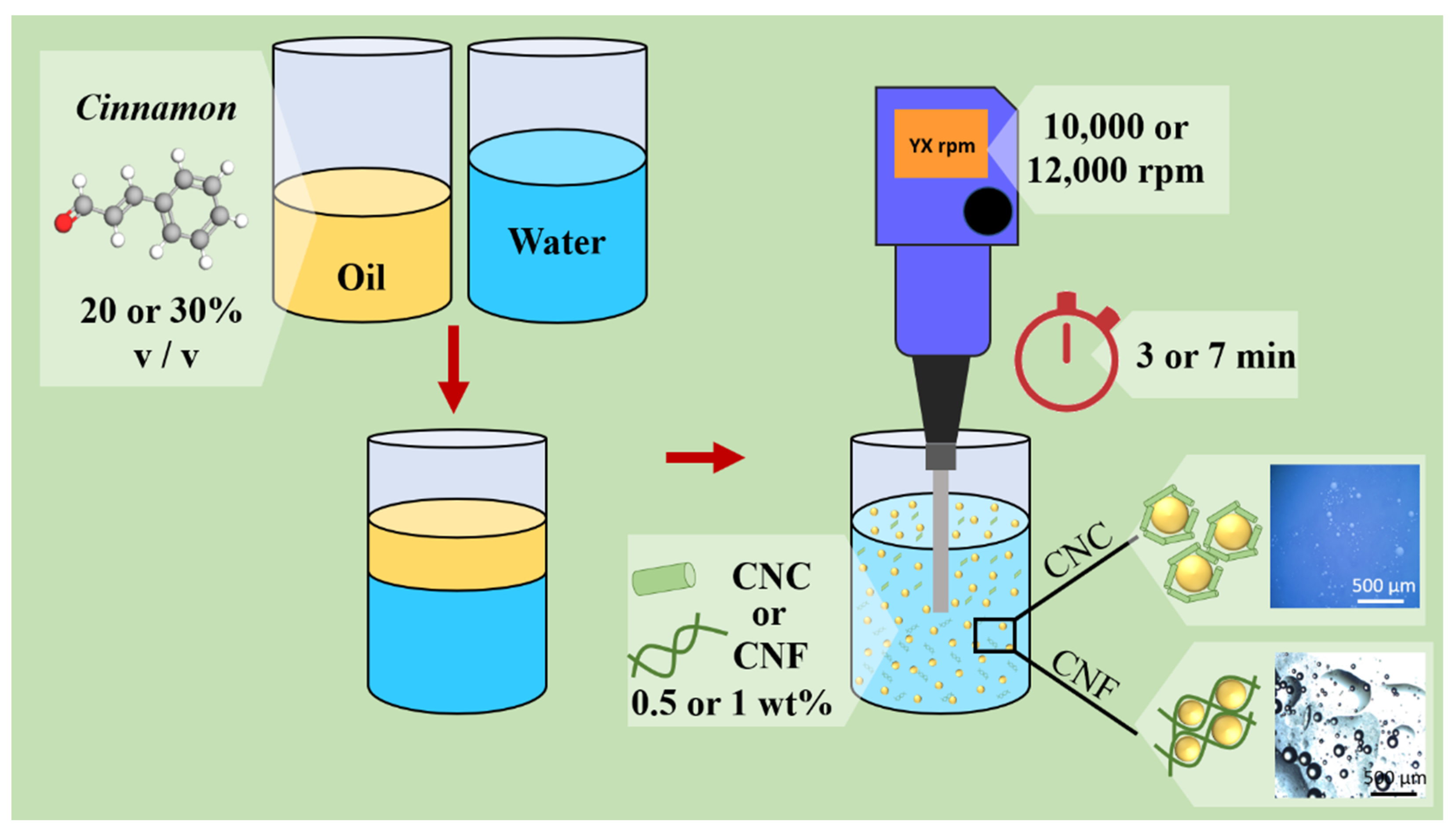
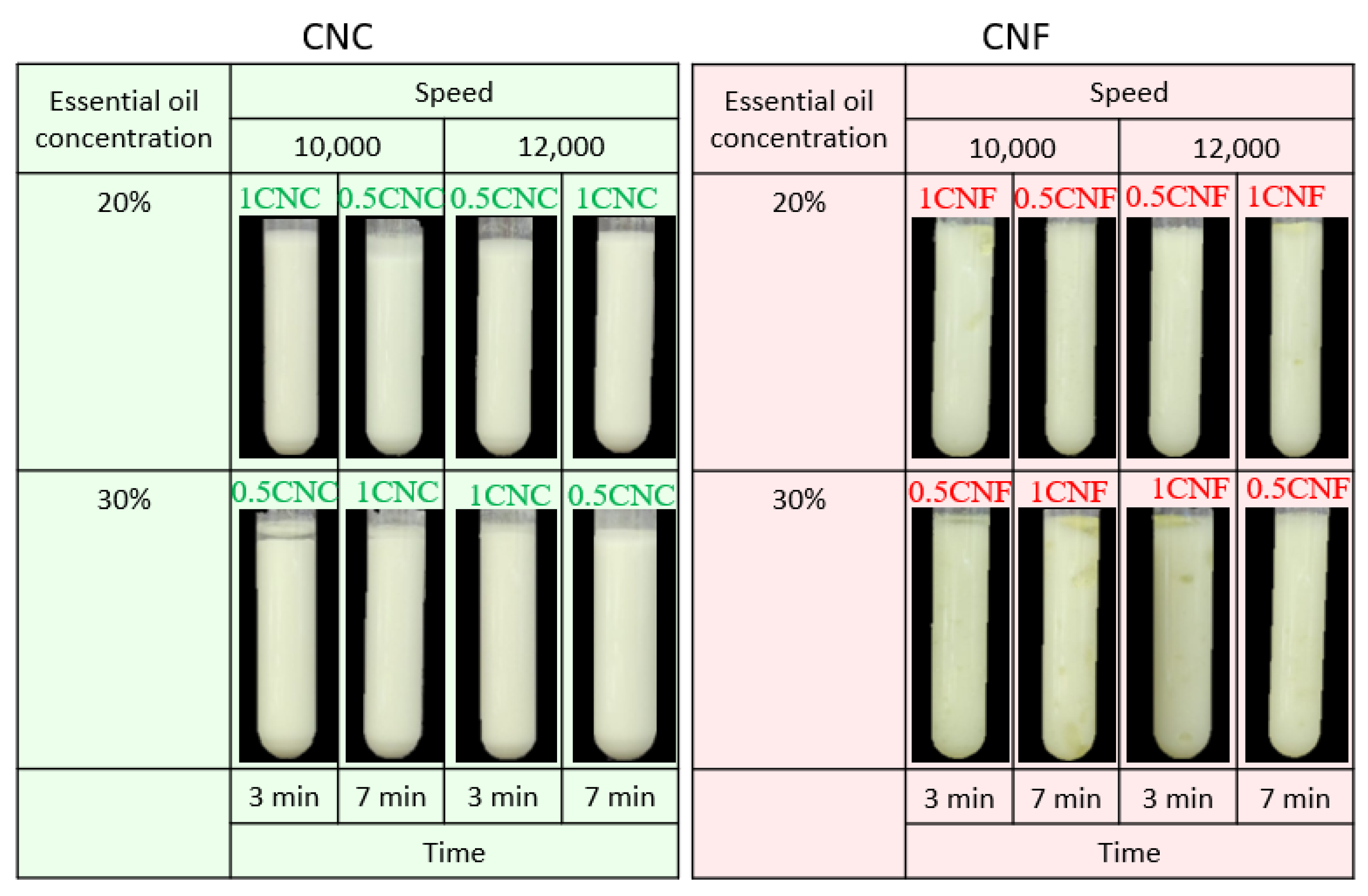
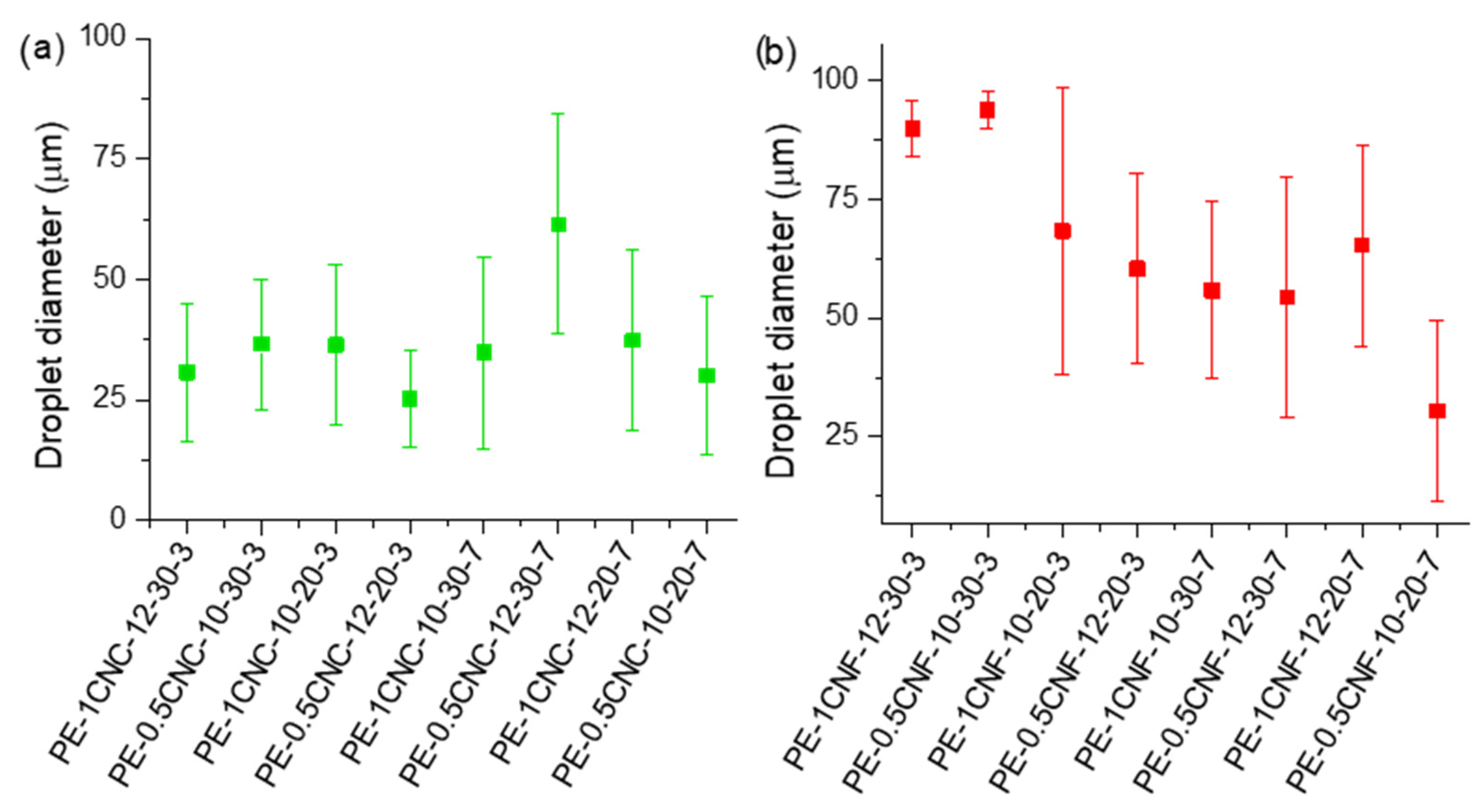
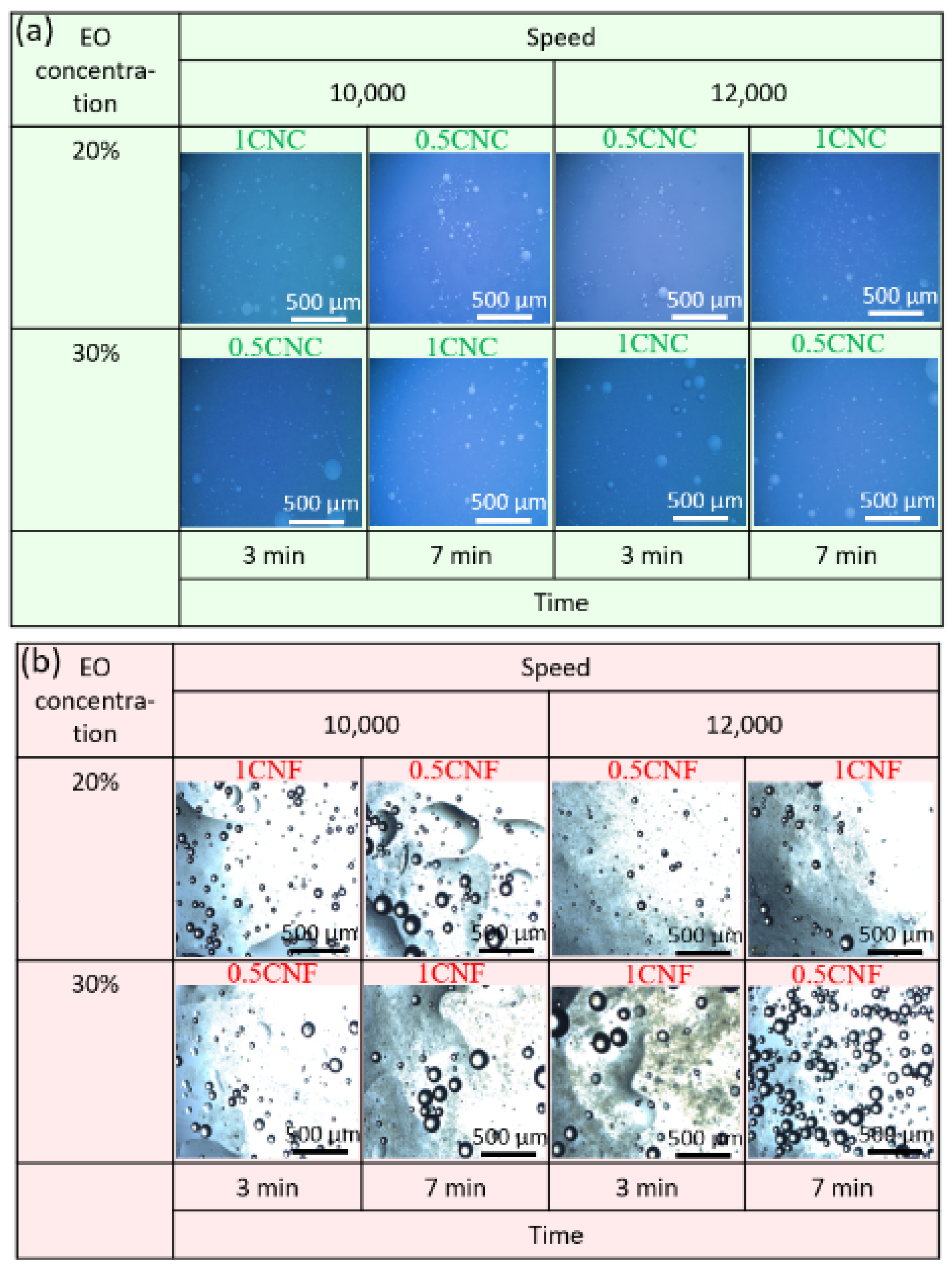
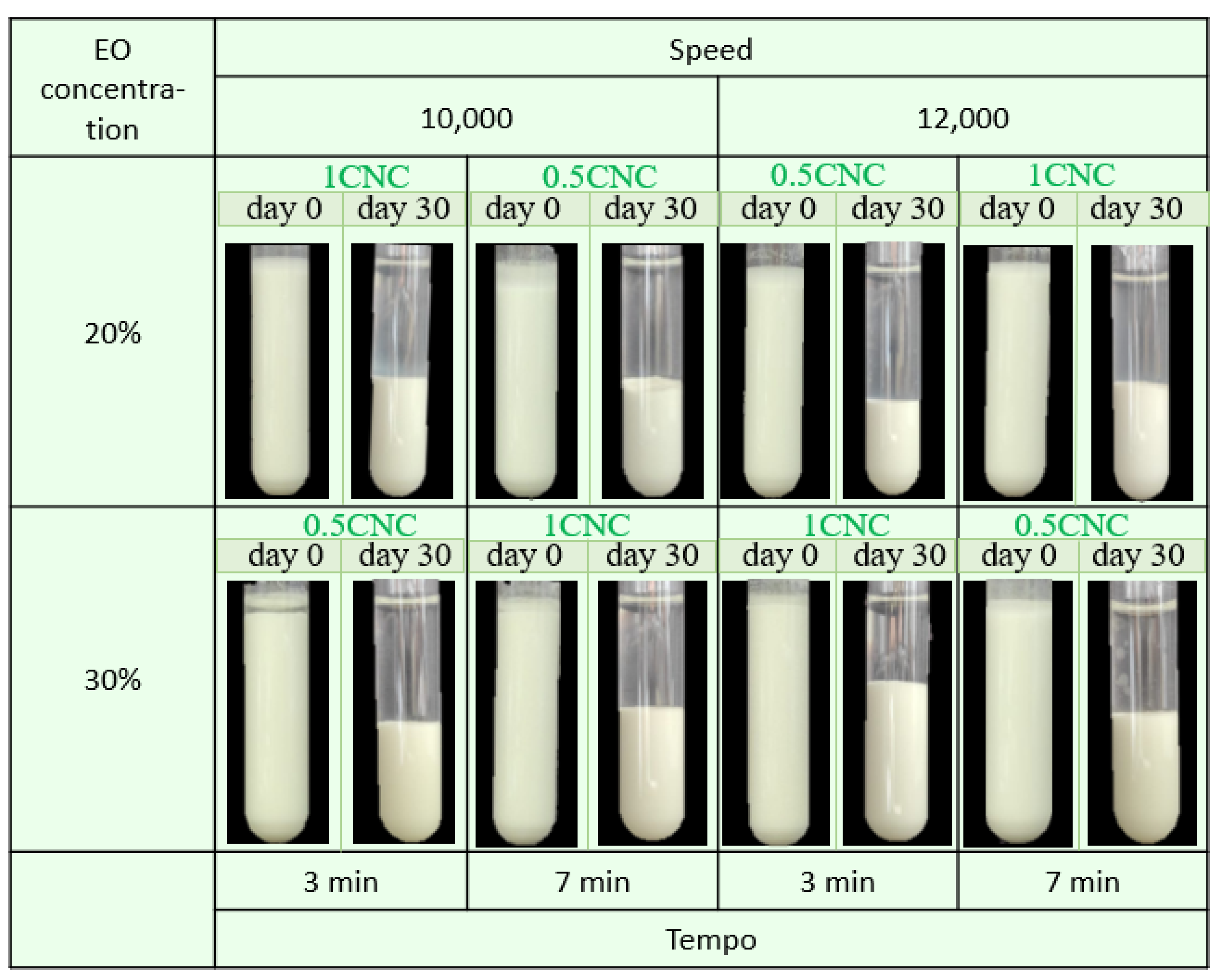
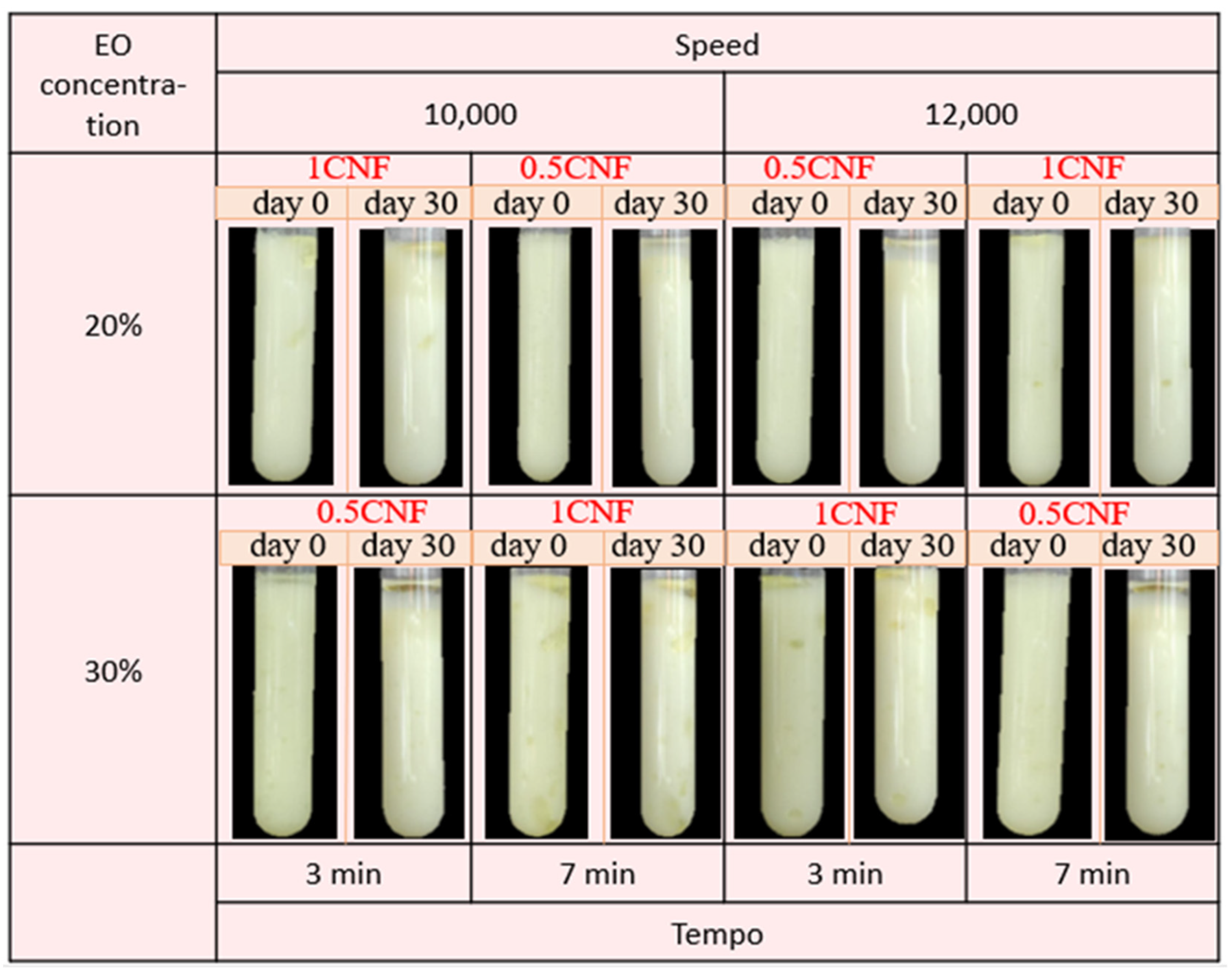
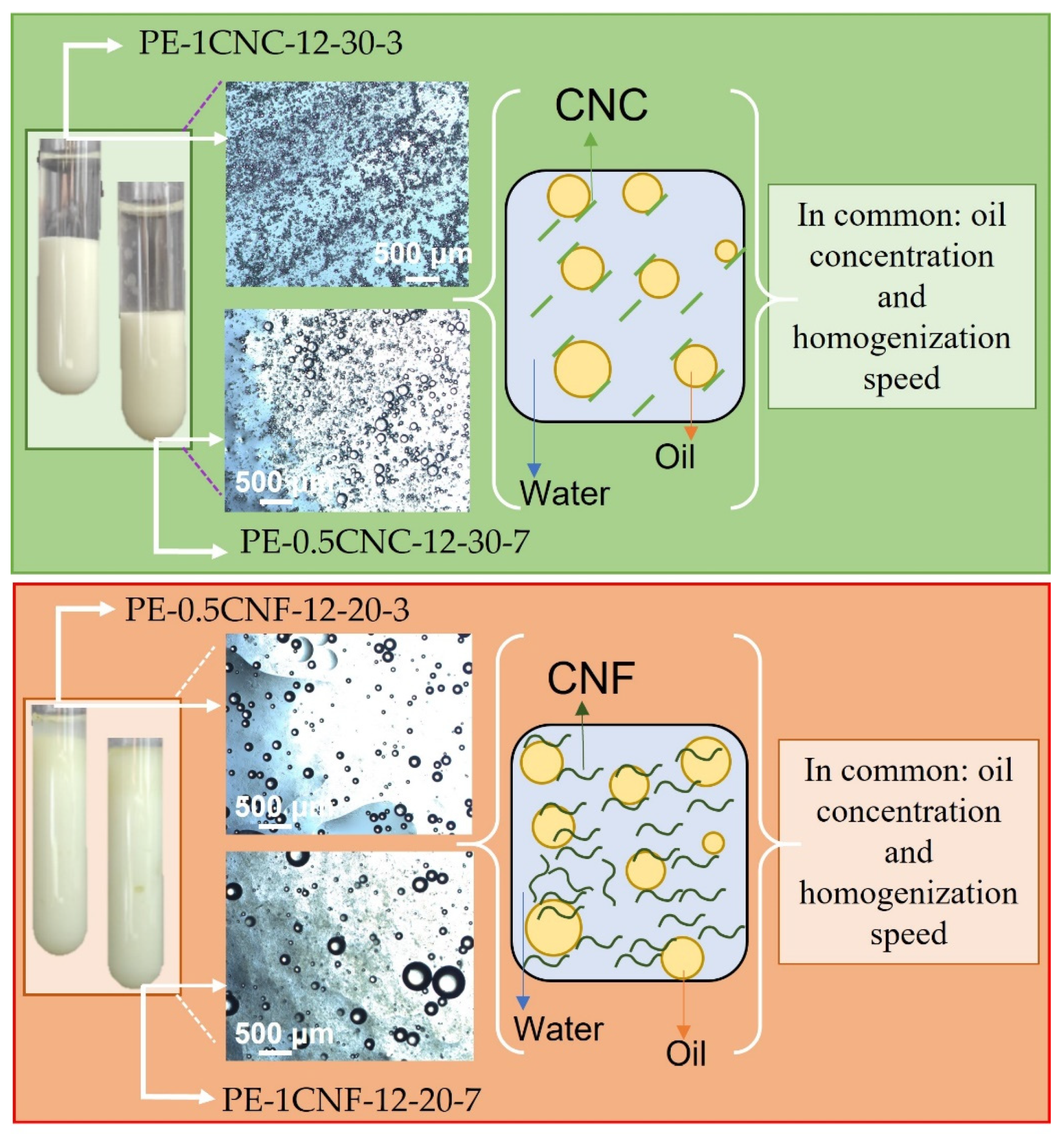
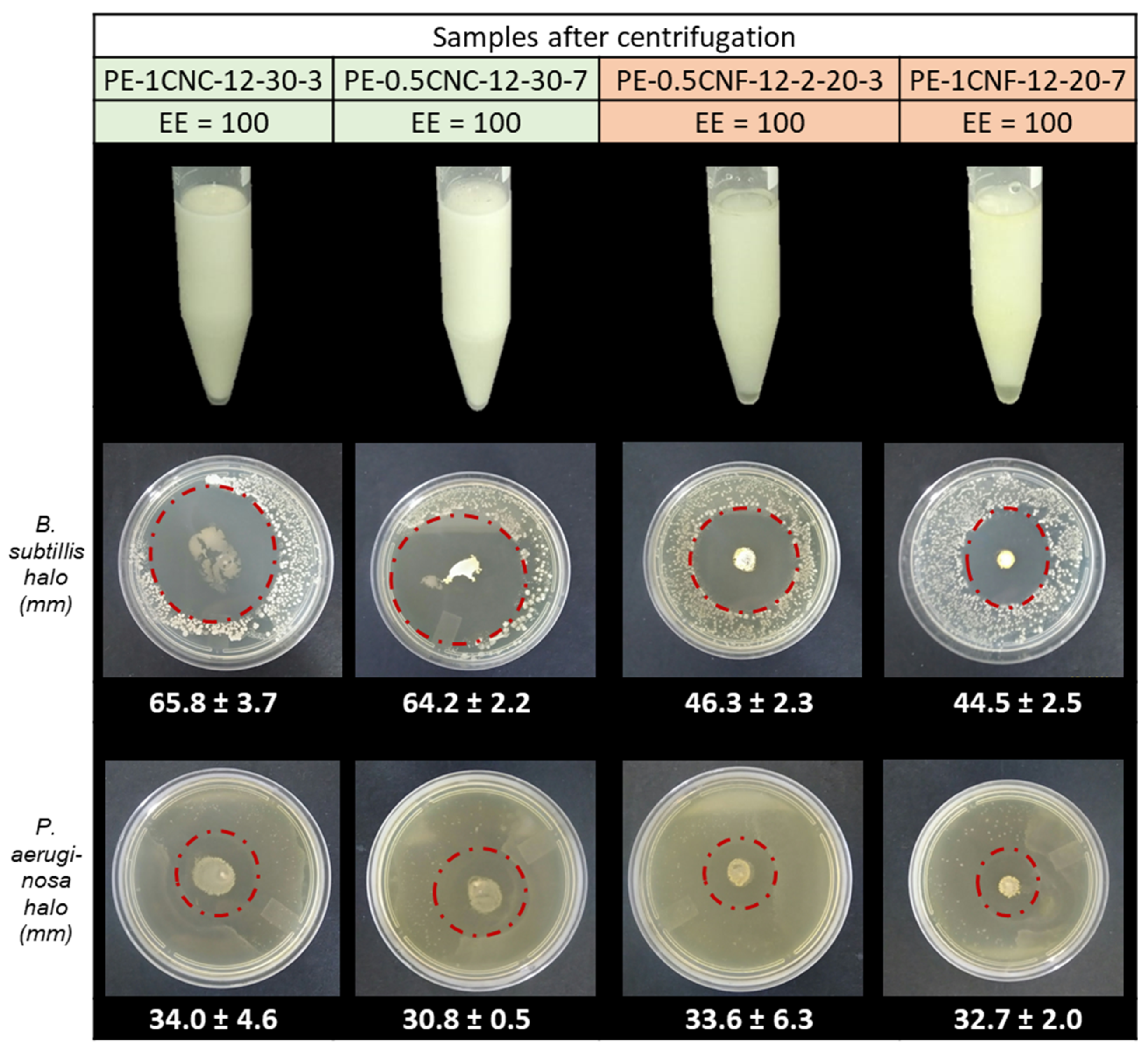
| Reference | Oil | Speed | O/W Ratio | Time | Cellulose Morphology | Cellulose Concentration | Stability |
|---|---|---|---|---|---|---|---|
| [35] | Ho wood | 5000 rpm | 20/80 | 40 min | CNF | 0.75 wt% | 50% |
| Cinnamon | 5000 rpm | 20/80 | 40 min | CNF | 0.75 wt% | 65% | |
| [30] | Clove oil | 22,000 rpm | 10/90 | 1 min | CNC | 0.1, 0.25, and 0.5 wt% | “good” |
| [36] | Dodecane | 11,000 rpm | 10/90 | 4 min | CNF | 0.05, 0.1, 0.15, and 0.2 wt% | “high” |
| [27] | Palm oil | 10,000 rpm | 50/50 | 3 min | CNF | 1 wt% | “high” |
| [37] | Corn oil, Silicone oil, and Limonene | 15,000 rpm | 25/75 | 3 min | Semicrystalline cellulose oligomers | 0.2, 0.4, 0.6, 0.8, 1.0, and 1.2 wt% | Between 40 and 100% |
| [38] | Dodecane | 10,000 rpm | From 10/90 to 50/50 | 2 min | CNF | 0.1–0.5 wt% | Between 60 and 100% |
| [12] | Dodecane | 24,000 rpm | 20/80 and 35/65 | 2 min | CNF | 0.1, 0.5, 1.0, and 1.5 wt% | Low oil concentration -> low stability |
| [39] | Dodecane | 12,000 rpm | 10/90 | 3 min | Microcrystalline | 0.5–2 wt% | “high” |
| [23] | Almond oil | 20,000 rpm | 30/70 | 5 min | Cationic CNF | 0.5 and 1 wt% | 99% |
| [40] | Palm olein | 10,000 rpm | 20/80 | 5 min | CNC | 0.15 and 0.3 wt% | 100% |
| [41] | Olive oil | 12,000 rpm | 10/90, 30/70, and 50/50 | 2 min | CNF | 0.05, 0.1, 0.2, and 0.25 wt% | Between 60 and 100% |
| Nomenclature | Processing Conditions |
|---|---|
| PE 1-1CNC-12-30-3 | 1% CNC, 12,000 rpm, 30% oil, 3 min |
| PE-0.5CNC-10-30-3 | 0.5% CNC, 10,000 rpm, 30% oil, 3 min |
| PE-1CNC-10-20-3 | 1% CNC, 10,000 rpm, 20% oil, 3 min |
| PE-0.5CNC-12-20-3 | 0.5% CNC, 12,000 rpm, 20% oil, 3 min |
| PE-1CNC-10-30-7 | 1% CNC, 10,000 rpm, 30% oil, 7 min |
| PE-0.5CNC-12-30-7 | 0.5% CNC, 12,000 rpm, 30% oil, 7 min |
| PE-1CNC-12-20-7 | 1% CNC, 12,000 rpm, 20% oil, 7 min |
| PE-0.5CNC-10-20-7 | 0.5% CNC, 10.000 rpm, 20% oil, 7 min |
| PE-1CNF-12-30-3 | 1% CNF, 12,000 rpm, 30% oil, 3 min |
| PE-0.5CNF-10-30-3 | 0.5% CNF, 10,000 rpm, 30% oil, 3 min |
| PE-1CNF-10-20-3 | 1% CNF, 10,000 rpm, 20% oil, 3 min |
| PE-0.5CNF-12-20-3 | 0.5% CNF, 12,000 rpm, 20% oil, 3 min |
| PE-1CNF-10-30-7 | 1% CNF, 10,000 rpm, 30% oil, 7 min |
| PE-0.5CNF-12-30-7 | 0.5% CNF, 12,000 rpm, 30% oil, 7 min |
| PE-1CNF-12-20-7 | 1% CNF, 12,000 rpm, 20% oil, 7 min |
| PE-0.5CNF-10-20-7 | 0.5% CNF, 10,000 rpm, 20% oil, 7 min |
| Sample | CI | ||||
|---|---|---|---|---|---|
| Day 0 | Day 10 | Day 15 | Day 21 | Day 30 | |
| PE-1CNC-12-30-3 | 0 | 30.7 | 33.1 | 33.9 | 34.4 |
| PE-0.5CNC-10-30-3 | 0 | 45.8 | 47.5 | 49.1 | 49.2 |
| PE-1CNC-10-20-3 | 0 | 48.7 | 49.1 | 50.4 | 52.3 |
| PE-0.5CNC-12-20-3 | 0 | 55.8 | 59.2 | 59.4 | 59.5 |
| PE-1CNC-10-30-7 | 0 | 41.1 | 42.7 | 43.4 | 45.3 |
| PE-0.5CNC-12-30-7 | 0 | 41.4 | 41.6 | 42.8 | 42.8 |
| PE-1CNC-12-20-7 | 0 | 45.9 | 48.2 | 49.9 | 52.3 |
| PE-0.5CNC-10-20-7 | 0 | 50.1 | 54.0 | 55.2 | 55.6 |
Publisher’s Note: MDPI stays neutral with regard to jurisdictional claims in published maps and institutional affiliations. |
© 2021 by the authors. Licensee MDPI, Basel, Switzerland. This article is an open access article distributed under the terms and conditions of the Creative Commons Attribution (CC BY) license (https://creativecommons.org/licenses/by/4.0/).
Share and Cite
Souza, A.G.d.; Ferreira, R.R.; Aguilar, E.S.F.; Zanata, L.; Rosa, D.d.S. Cinnamon Essential Oil Nanocellulose-Based Pickering Emulsions: Processing Parameters Effect on Their Formation, Stabilization, and Antimicrobial Activity. Polysaccharides 2021, 2, 608-625. https://doi.org/10.3390/polysaccharides2030037
Souza AGd, Ferreira RR, Aguilar ESF, Zanata L, Rosa DdS. Cinnamon Essential Oil Nanocellulose-Based Pickering Emulsions: Processing Parameters Effect on Their Formation, Stabilization, and Antimicrobial Activity. Polysaccharides. 2021; 2(3):608-625. https://doi.org/10.3390/polysaccharides2030037
Chicago/Turabian StyleSouza, Alana Gabrieli de, Rafaela Reis Ferreira, Elisa Silva Freire Aguilar, Leonardo Zanata, and Derval dos Santos Rosa. 2021. "Cinnamon Essential Oil Nanocellulose-Based Pickering Emulsions: Processing Parameters Effect on Their Formation, Stabilization, and Antimicrobial Activity" Polysaccharides 2, no. 3: 608-625. https://doi.org/10.3390/polysaccharides2030037
APA StyleSouza, A. G. d., Ferreira, R. R., Aguilar, E. S. F., Zanata, L., & Rosa, D. d. S. (2021). Cinnamon Essential Oil Nanocellulose-Based Pickering Emulsions: Processing Parameters Effect on Their Formation, Stabilization, and Antimicrobial Activity. Polysaccharides, 2(3), 608-625. https://doi.org/10.3390/polysaccharides2030037






